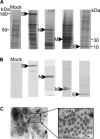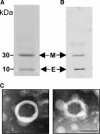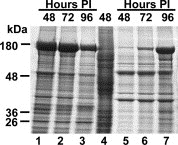Efficient assembly and release of SARS coronavirus-like particles by a heterologous expression system
- PMID: 15474033
- PMCID: PMC7126153
- DOI: 10.1016/j.febslet.2004.09.009
Efficient assembly and release of SARS coronavirus-like particles by a heterologous expression system
Abstract
Virus-like particles (VLPs) produced by recombinant expression of the major viral structural proteins could be an attractive method for severe acute respiratory syndrome (SARS) control. In this study, using the baculovirus system, we generated recombinant viruses that expressed S, E, M and N structural proteins of SARS-CoV either individually or simultaneously. The expression level, size and authenticity of each recombinant SARS-CoV protein were determined. In addition, immunofluorescence and FACS analysis confirmed the cell surface expression of the S protein. Co-infections of insect cells with two recombinant viruses demonstrated that M and E could assemble readily to form smooth surfaced VLPs. On the other hand, simultaneous high level expression of S, E and M by a single recombinant virus allowed the very efficient assembly and release of VLPs. These data demonstrate that the VLPs are morphological mimics of virion particles. The high level expression of VLPs with correct S protein conformation by a single recombinant baculovirus offers a potential candidate vaccine for SARS.
Copyright 2004 Federation of European Biochemical Societies
Figures





References
Publication types
MeSH terms
Substances
LinkOut - more resources
Full Text Sources
Other Literature Sources
Molecular Biology Databases
Miscellaneous

